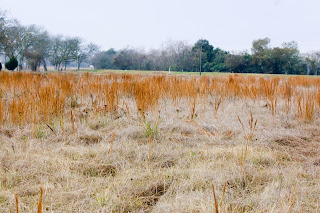I was walking across the short, matted grass of this slightly wet field hoping to kick a Le Conte's Sparrow out of the rust-colored broomsedge in the background when a little bird flushed weakly out at my feet. I saw that it was a grass sparrow, but surprisingly, the bird looked rusty brown instead of blond like a Le Conte's. I quickly followed it, and kicked up another like it on the way, also out of the thick, matted pale grass.
By the time I got to the spot where the first bird had hit the ground, it must've done some running, because it didn't flush again. However, I happened to notice a bird looking at me from a dense clump of some other kind of grass twenty or thirty feet away. Did it run that fast?
Luckily the sun had come out after a rainy night, and it looked like the bird was comfortable basking in rays. These little grass sparrows are usually easiest to see at times when they crave the sun, such as a sunny morning after a frosty night, or when the sun comes out after a rain. I put the camera to my eye and started walking toward the bird, and got pretty close.
The greenish ground color of the face, the wide white eye-ring, and the necklace of streaks are all good field marks. So is the rusty back, although the beautiful colors and intricate pattern of the back don't get the attention I think they deserve. This is one beautiful little bird.
I ended up flushing 3 of these birds, but only this one gave me an extended look.
These birds are most common in the winter in pine savannas, especially when those grasslands have been burned recently. I don't know if this field is typical of what Henslow's Sparrow like on the coastal prairie. I've walked through fields like this before without luck, and I've seen them in thicker fields that have more upright grass mixed with broomsedge. Whatever the case, it gives me a new possibility to explore when looking for these birds.




1 comment:
Wow, neat! I wonder if these are migrant overshoots. From our work in the pine savannas of SE LA, numbers climb and birds are moving around through at least mid-Dec. By late December, each bird has settled into a small (<1 ha) home range and densities slowly diminish through the winter at a rate consistent with mortality estimates we derived.
Post a Comment